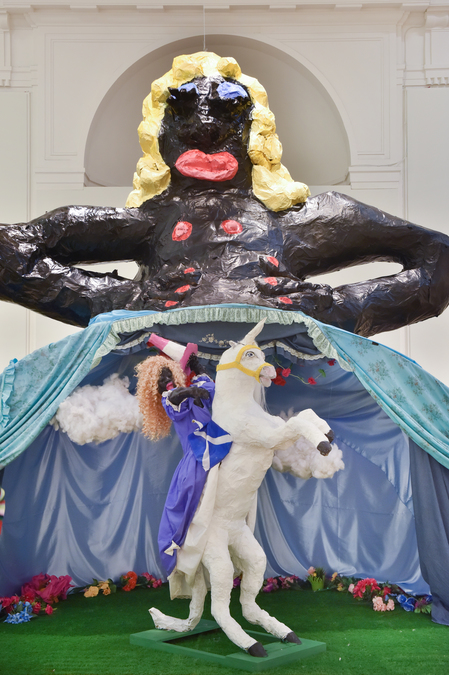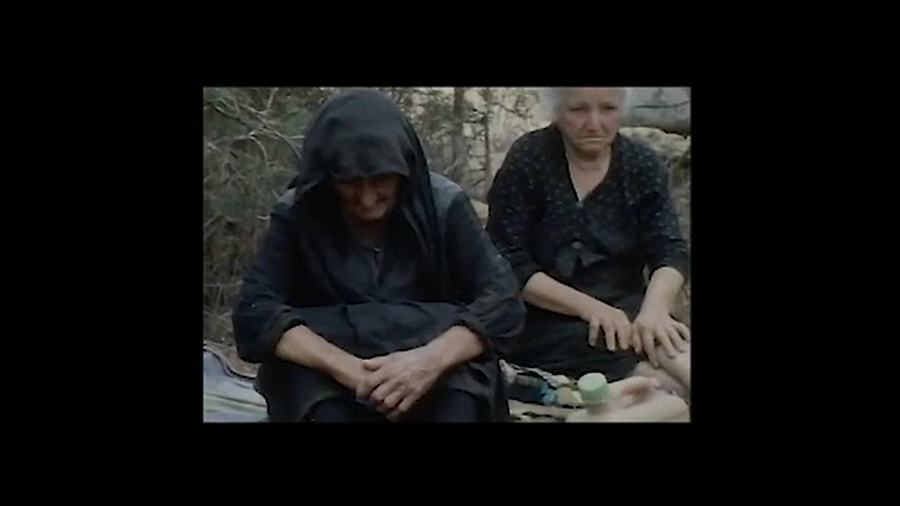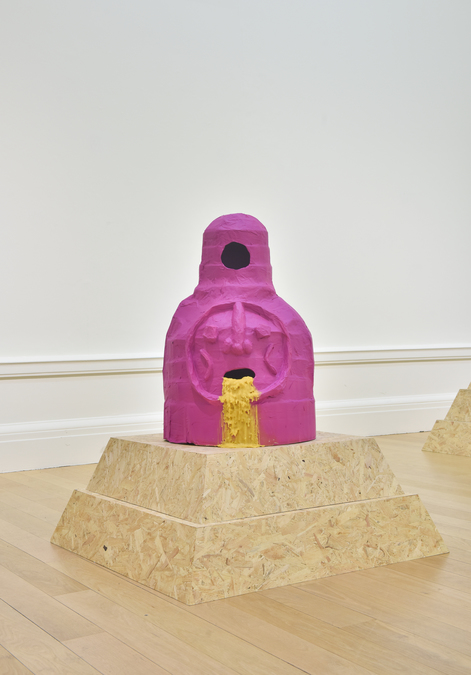Art Futures: RSA New Contemporaries 2023
The Royal Scottish Academy’s New Contemporaries returns to celebrate the artists and architects who graduated from Scotland’s art schools in 2021
The selected artists and architects currently showing on the Mound all graduated from one of the following Scottish art schools: Duncan of Jordanstone College of Art and Design (DJCAD), Edinburgh College of Art (ECA), Glasgow School of Art (GSA), Gray's School of Art and the University of the Highlands and Islands. Spread across the vast spaces of the Academy, this year’s artists unveil works that address themes including problematic statues, queer world-building and natural ecologies. This month, The Skinny profiles six of the artists selected to exhibit at this year’s New Contemporaries.
Josie KO
Glasgow-based Josie KO’s epic and evocative sculpture Lady in Blue is the immediate star of the show, visible as soon as you climb the stairs to the Academy’s upstairs space. A large Black figure, hands on hips, towers over the audience; below her, a smaller figure rides on horseback, saltire and pink traffic cone in hand, mouth wide in ecstasy. The artist’s playful papier mâché and textile constructions feed into current conversations around the relevance of public statues in our civic spaces that depict problematic, colonial-era figures. Her work satirises these monuments while posing serious questions about why monuments to imperialists and slave traders are still standing – and what (and who) should replace them. The artist’s work demonstrates that imaginative and artistic interventions into such heavy conversations are needed – and that artists can, and should, play a crucial and critical role in deciding what fills our public spaces.

Of all the works on display, the joy and relishing of making is most evident in KO’s practice. The sculpture itself is colossal, and there is a real sense of the amount of labour that has gone into its construction: a combination of papier mâché, woodwork and textiles. The way that the sculpture stands, epic, firm and resolute, channels Simone Leigh’s installation at last year’s Venice Biennale, and its desire to take up space also connects the practices of the two artists. This work also reflects on KO’s experience of moving to Glasgow as a Black woman, evidenced by the saltire flag and neon pink traffic cone held by the smaller figure.
N. Godjamanian
N. Godjamanian, a graduate of ECA, is exhibiting two short but haunting films that capture dual scenes of grief. The first, found footage of a Cypriot woman grieving at the loss of her home following an eviction during the island’s conflict in 1974: the second, a depiction of a house burning from the ongoing Nagorno-Karabakh conflict in Armenia and Azerbaijan. The films capture the cycles of loss, grief and trauma that conflict creates, and forces the viewer to examine how they consume images of human suffering. Godjamanian poses the question – how do we respond to images of human suffering that float through news channels and social media in an endless loop?

The choice to use depictions of two lesser-known conflicts, both taking place on the fringes of Europe, draws attention to how the West represents conflict through its media – often-time, to privilege its own agenda. This has become especially evident with the war in Ukraine, and how European nations have expressed horror and concern in response to the conflict, while ignoring the plight of people fleeing conflict in the global south. Godjamanian’s films provoke us to think – whose suffering is deemed worthy of empathy by the West, and whose is not?
Emily Weaver
Emily Weaver’s sculptures and film speak to the fundamental role that bees play in the Earth’s ecosystems. While many artists in this year’s New Contemporaries make reference to ecologies in their practice, Weaver’s exploration is the most thorough and comprehensive. Three beehive sculptures, made of papier mâché and beeswax, are spray painted in vivid pink, yellow and gold. Based on the designs of ornate sculpted beehives found in Germany and in Scandinavia, they feature stylised faces that act as icons, like those that often embellish religious buildings.

Her accompanying film Ultraviolet Dreams is delightfully inventive and un-pretentious. In the film, bees are shown to be an all-seeing witness to human activity. Weaver draws on Greek and Roman mythologies, who believed that bees are the messengers of the gods – this metaphor operates to highlight the precarious entanglement of bees and human existence. The film is a vivid and intimate collage of drawings and performances, with its thoughtful and beguiling costumes and masks, which make reference to the myths of the Bugonia Ox and Samson’s Lion, in which bees play a central role.
Carlos Anguera
Anguera (a graduate of GSA) is exhibiting one work for New Contemporaries – an epic, tapestry-like photographic collage titled Club Tanners, Crowd Sitters, Shadow Eaters. At around three metres long, it has immense visual power from a distance – but its curious details emerge as you move closer. Transcending form and medium, it is painterly but firmly grounded in a range of photographic techniques. Now based in Berlin, Anguera works with photography, video and installation. As is demonstrated across their practice, the artist deconstructs the mechanisms of image-making, pulling apart the limitations of digital and analogue processes.
Their work for New Contemporaries deploys what Anguera calls ‘visual composites’ – multilayered still and moving image arrangements which create playful but formal arrangements. Smaller images, printed in the shape of a phone, glide around larger images of a disco ball, spherical leather sculptures suspended mid-air with metal chains, and a circular cut-out that resembles a satellite image of mountains, or perhaps a dense area of cloud.
Len Goetzee
Goetzee studied BA (Hons) Fine Art at DJCAD and graduated from GSA with an MLitt in Fine Art Practice. The artist uses their voice and the practice of speculative writing as conduit in their fluid and theatrical performances and films. Using what they term ‘queer scavenger methodologies’, world-building is imagined in both the micro and the macro – moving from lived experience of transition into the public realm, and beyond.

In their live performance at New Contemporaries, their use of their almost-operatic voice is melodramatic and whimsical, at one moment close to hysterical laughter, the next a kind of desperate wail – the audience watches with anticipation and curiosity. The accompanying films work to invigorate the lyricism of the live performances. Titled HEY! and SPIT’S SONNET, they create an effective call and response, and it seems as if their digital figure might jump from the screen at any moment. The films work inventively to imagine new worlds despite the confines of domesticity – Goetzee appears to have made the most of being forced to work from home during the pandemic. Their practice joyfully revels in the disorder of our times.
Faye Eleanor Woods
Woods’ paintings inject some much needed humour into the New Contemporaries. Her paintings explore mythologies of the Calderdale Valley in West Yorkshire – and her love of the pub. The set of three paintings are based on the historical tale of Lady Sybil, a shape-shifting witch who frequented the moors of the area.

At once dreamlike and unsettling, Woods’ landscapes are blustery, and her figures wild and wayward. In one painting, a green figure stands amongst trees, smoking a cigarette, engrossed in a book titled I Wish I Was At The Pub. Her hair and scarf are described fluidly, and her hand seems to melt into the cigarette smoke that drifts off skyward. Given the timing of the artist’s graduation during lockdown, this humorous gesture also has a solemn underbelly – pubs, many people’s sole social space, remained closed for much of the lockdown. Meanwhile, the epic and fantastical I have sold my soul for this pint and I have no regrets shows us the breadth of Woods’ abilities, combining Baroque-esque drama and detail, the brooding menace of Arthur Conan Doyle’s The Hound of the Baskervilles and the ecstasy of drunken escapades.
RSA New Contemporaries 2023, Royal Scottish Academy, Edinburgh, £8/5 (free on Mondays), until 16 Apr
royalscottishacademy.org
